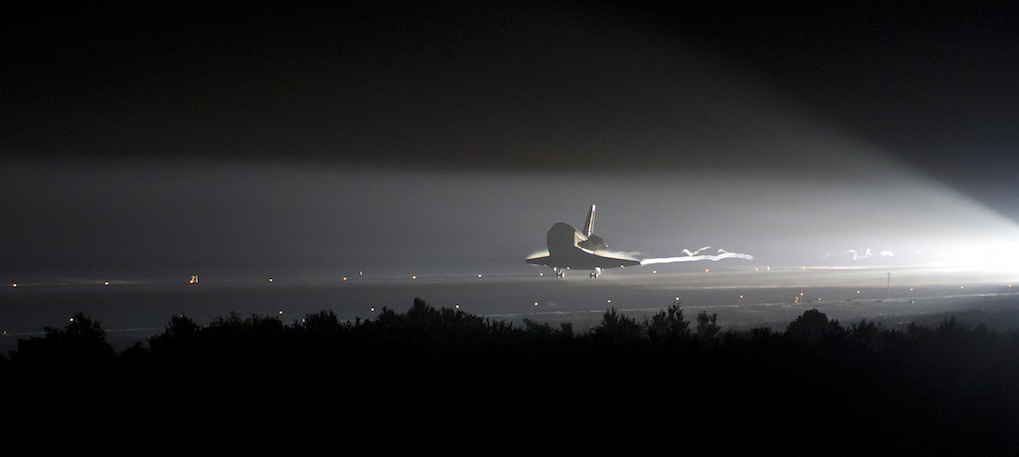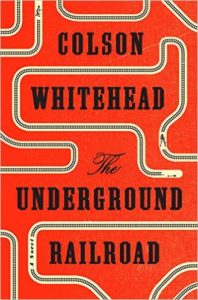
By Victoria Hoyle
The Underground Railroad — Colson Whitehead (Fleet)
 All historical fiction is alternate historical fiction, to a greater or lesser extent.
All historical fiction is alternate historical fiction, to a greater or lesser extent.
The setting is always other than it was; necessarily so, because we can only access the past through the imperfect lens of the present. Our 21st century way of knowing the world may be intimately connected to the experiences of human beings one hundred, five hundred, even two thousand years ago, but it is also paradigmatically alien. When we imagine, interpret and co-opt those experiences to tell stories we do so in the spirit of conjecture. Which is not to say that historical fiction cannot strive for factual veracity, only that it can never be completely achieved. Speculation creeps in – in some cases more than others – and because of that historical fiction shares some essential qualities with science fiction: the will to imagine otherwise; the displacement of human experience in time; and the estrangement of the reader from the contemporary familiar. The great historical fiction writers of the last century – Mary Renault, Dorothy Dunnett, Patrick O’Brian, Hilary Mantel – wrote (and write, in the last case, we hope and pray) with the ferocious enquiry that I also associate with great SF. For which reason I have few qualms about the eligibility of Colson Whitehead’s The Underground Railroad – a book that harvests and reaps influences from both genres – for a science fiction award. I would have equally few about its eligibility for a historical fiction prize.[1]
It hardly seems necessary to rehearse the plot of the novel, especially as mine is the fourth Sharke review so far out of five short-listings. The central conceit is well known. Paul, Nick and Jonathan before me have written about the ways in which Whitehead conjures the metaphorical underground railroad of the 1850s as a physical reality, and how he uses that impossible infrastructure to transport escaped slave Cora, the book’s heroine, from one alternate US state to another. Each state is a law and a world unto itself, exploring different systems of racist oppression from genocidal mania to ‘negro uplift’, recalling the many incarnations of white entitlement expressed most odiously and eloquently in the person of the slave-catcher Ridgeway. The railroad metaphor made reality is, undoubtedly, a mighty narrative engine and a ticklish idea that hooks the imagination. It constructs the world of the novel, stitching its episodes together to underpin and make visible its structure. You can’t talk about The Underground Railroad without putting it front and centre, but since Nick and Paul have already covered the railroad’s thematic centrality, I want to consider instead how it shapes and creates the rhythm of the book.
Whitehead tells his story to a syncopated beat, like a train on a track. The longer chapters focused on Cora’s state-by-state escape are interrupted by shorter episodes that bring peripheral characters into sharp relief. In these chapters we glimpse the experiences of Cora’s mother Mabel and grandmother Ajarry; of her enemies Ridgeway and Dr Stevens; and of two people instrumental in her survival, her fellow slave Caesar and Ethel a white woman who begrudgingly hides Cora in her attic. Their stories temporarily displace the central narrative into the margins, casting light on the motives and actions of individuals in context. They are also by far the most historical and un-sf-nal elements of the book (if you will excuse the awkward construction). The now-famous underground railroad barely features in these sections; instead we are invited to consider the characters out from under its speculative shadow. They also have a distinctive stylistic flavour that sets them apart. The main sections of the book have a tone established by the fantastical nature of the railroad: allegoric, dreamlike, parable-esque. While it is possible to read Cora’s storyline straight – i.e. as a sequence of events that happens to a character named Cora – it’s clear that Whitehead also intends us to read it figuratively, as an allegory of systemic racism in America, from the advent of transatlantic slavery to the present day. The interpolated chapters serve as a counterpoint to this mode of storytelling.
When we find ourselves straying too far into the badlands of symbolic trope, they anchor us back into the historicity of the narrative. With their period detail – references to material culture, to money, to food – they remind us that the things we are reading about did happen, if not in precisely the ways and places imagined. The sf-nal ambition of the novel is interwoven with this history, each dominating and retreating in turn. This is a complicated balance to pull off and the railroad acts as a binding agent, linking the past to the alternate past. It works as a concept that is both historically true to the period in which the book is apparently set – an underground network of former slaves, free black people and white allies did indeed help slaves to escape to Canada in the mid-nineteenth century – and science fictionally true to the alternative realities it proposes. It makes it possible for us to move seamlessly between the two ways of thinking about stories, both alien and familiar at once.
The Underground Railroad is like The Fifth Season in that it plucks and picks from a varied fictional inheritance – slave narratives, parables, histories, dystopias, fantasies and science fictions – to fuel its engines (literal and otherwise). It also confronts some similar questions. Like Jemisin (and, to a lesser extent, Lee in Ninefox Gambit) Whitehead describes regimes founded on racial prejudice and the judicial abuse of power and asks ‘How does change happen?’ and, more fundamentally, ‘Is change possible?’. The railroad is the starting point of an answer. In the novel its physical reality is the work of the many men and women who built it, travelled on it and allowed it to continue existing:
The ones who excavated a million tons of rock and dirt, toiled in the belly of the earth for the deliverance of slaves like her. Who stood with all those other souls who took runaways into their homes, fed them, carried them north on their backs, died for them. The station masters and conductors and sympathizers. (p303-4)
It’s a manifestation of the countless unnamed people who fought for the freedom of slaves and the civil rights of African Americans, and a recognition of the real change wrought – to the body of the earth itself – by kindness, compassion and individual actions in the name of justice. Whitehead’s answer to the question of change places emphasis on the potential for positive outcomes through the work of many hands. It is not naïve about what can be achieved or the pace of change though. At the end of The Underground Railroad we leave Cora on the road again, still running, having a fresh escape from the most recent betrayal and grief of her life. The railroad is at risk of discovery and collapse. Her journey towards freedom, peace and fair opportunity is ongoing, a recognition that the cycle of racism, hatred and fear that justified slavery in the nineteenth century is unresolved. If the last 12 months have taught us anything, it’s that we still have incalculably far to go in securing a more equitable society. Nevertheless, she goes on beyond the pages of the novel and so does the struggling hope of the railroad, the promise of the goodness and fellow-feeling of strangers. Even after all the horrors the book has shown us, even after all that Cora has lost, it still ends with possibility.
That possibility entails a great deal of sacrifice and pain. Both for Cora and for those around her: “Running away was a transgression so large that the punishment enveloped every generous soul on her brief tour of freedom.” (p215) Whitehead is unflinching in exploring the horrifying and excruciating deaths visited on those who attempt to question or subvert the status quo. It would feel excessive if it weren’t all well documented and accurate. Given that almost everyone around her is eaten up by the horror of the system, we have to ask: why Cora? Why does she survive? What is special about her? Whitehead seems to suggest that it is quite simple: other people believe she is and she believes it too. Her mother’s successful escape from the plantation when Cora was a child gives her an aura of difference. When she takes actions that mark her out from her fellow slaves it feeds their conviction. When she flings herself down to protect the boy Chester from a beating at the start of the novel, a catalyst that leads to her own escape, she does it “before the slave part of her had caught up with the human part of her.” (p34) Somehow she has preserved her sense of self, despite pitiful treatment by both slavers and enslaved alike. Caesar, the man she escapes with, believes it is because “she was a stray through and through, so far off the path it was like she’d already run from the place long ago.” (p235) As Cora travels, learns to read and debates slavery with others, she demonstrates a capacity to understand and work against the systems in which she finds herself. She has an astute consciousness and a gift for non-compliance.
It’s difficult to balance the nature of Cora’s position as a special and particular heroine, an individual with a trajectory that makes sense for her, with her other figurative and allegorical role. The tension between history and science fiction, between genres, is played out in her body. Whether the novel works for you or not seems to rest on whether you think Cora remains a person after the narrative switches up from pure historical to speculative fiction. Is the Cora who gets off the underground railroad in South Carolina still sufficiently real to carry the thematic burdens the book puts on her? For me, yes, because of the structural mechanics I’ve described. There are enough historical touchstones to bind the message of the book into the story, so that rather than getting in the way of feeling for Cora, it imbues the whole with a deeper power. If I had read this book last year it would undoubtedly have been one of my best of 2016; instead it will probably be one of my best of 2017. It would be disingenuous of me to say it shouldn’t be on the Arthur C. Clarke shortlist; it should.
*
Victoria Hoyle is an archivist, blogger and part-time PhD student. She lives with her partner and a dog called Juno in rural North Yorkshire in the UK.
>> Read Victoria’s introduction and shortlist.
[1] The fact that it has been omitted from the Walter Scott Prize longlist this year is shocking to me, particularly as Kate Atkinson’s equally sf-nal A God in Ruins was listed in 2016.


